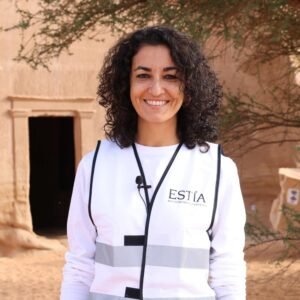The importance of time
AlUla, 1st March. It seems like yesterday that we arrived in Saudi Arabia, and yet, as they say, time flies, and our fifth month here in AlUla has already begun. In the month of February, our team gained Laure Teyssendier, a new important collaboration. With her, we will thoroughly consult the photographic archive of the Royal Commission for Alula (RCU) to reconstruct, along with the study of the available sources, the conservation history of the site.

The cataloging work of the Nabataean tombs in Hegra is progressing smoothly. We are about to start the study and data collection of the Sulaymiyya necropolis. After four months of direct observation on-site, our eye is trained to capture every detail useful to understand the execution technique and the phenomena of degradation of the Nabataean monuments. Anyone involved in restoration and conservation knows that a fundamental ally for the success of any work is time, especially on such an extensive site that continues to reveal continuous surprises. Indeed, we find new petroglyphs and other niches, even in very isolated positions compared to the necropolises. Then, to reach where our eye cannot reach, the use of the drone will likely allow us to observe and survey the tops of the tombs and the massifs.

What strikes us, especially in some hours of the day when the sunlight begins to fade, is the incredible balance between nature and what the Nabataeans managed to create two thousand years ago.
The fortresses and oasis of Khaybar
In addition to work, we have had an essential priority from the beginning: to explore this region of Arabia in our free time, usually on Saturdays. Our latest day trip took us to Khaybar, an ancient city 150 km north of Medina, once predominantly inhabited by Jews and later conquered by Mohammed in 628 AD. According to tradition, the toponym khaybar means fortress and indeed, two fortresses, quite similar to our medieval castles, dominate the valley where an oasis lies.

The fortifications are built on natural rocky massifs using mud bricks, beams made from palm tree trunks, and one or two layers of mortar, always based on earth and water but incredibly durable. The fortress is a labyrinthine interweaving of successive environments, and there is also a mosque where an ancient box containing some copies of the Quran is preserved. Currently, the site is not open to the public. We, as professionals in the field, had the opportunity to access it thanks to Rut Ballesteros from RCU, who is an endless source of information and inspiration for us.

For this site as well, a study on the state of conservation is planned, as part of the grand enhancement project that RCU is carrying out. Unlike the fortress, the lower oasis area is accessible and organized to welcome anyone who wants to linger here for an outdoor break. In the stream, you can observe small fish that, apparently, are an endemic species (Arabian bream). Of course, in Khaybar, we also tried and appreciated the typical Saudi cuisine: kabsa, mandi, harees, mutabbaq and various varieties of hummus. For those who enjoy walking, this is a perfect place: the surrounding terrain, mountainous and volcanic, is ideal for breathtaking hikes, with unforgettable sunsets



